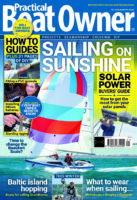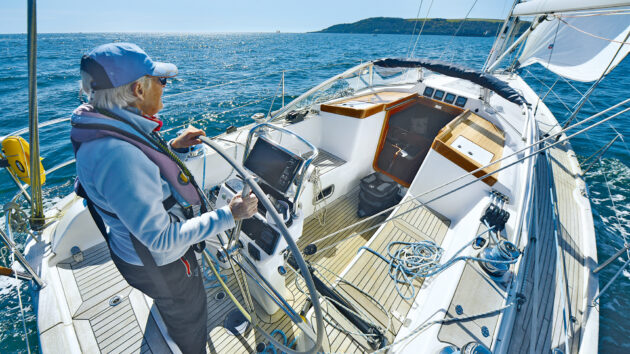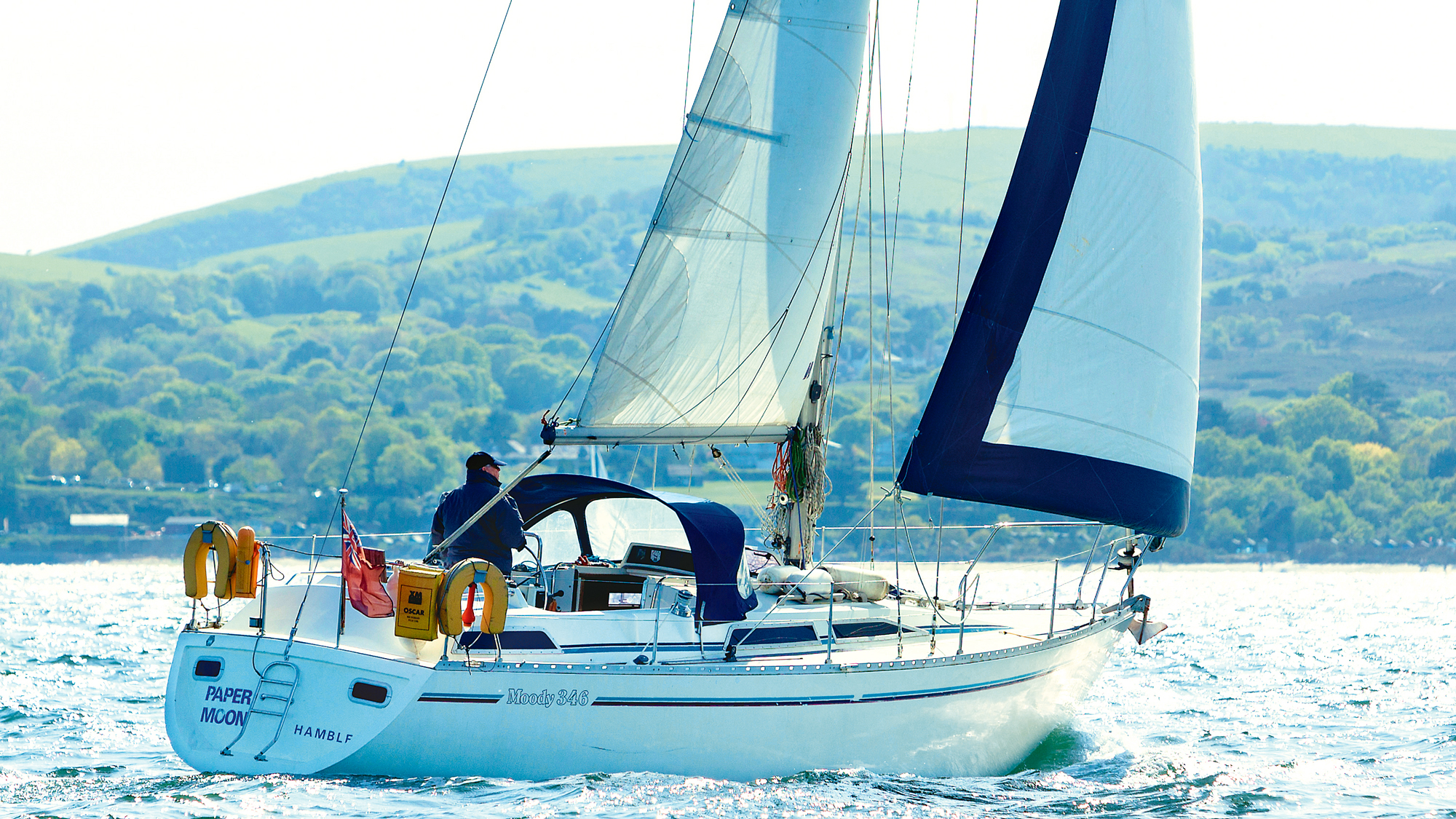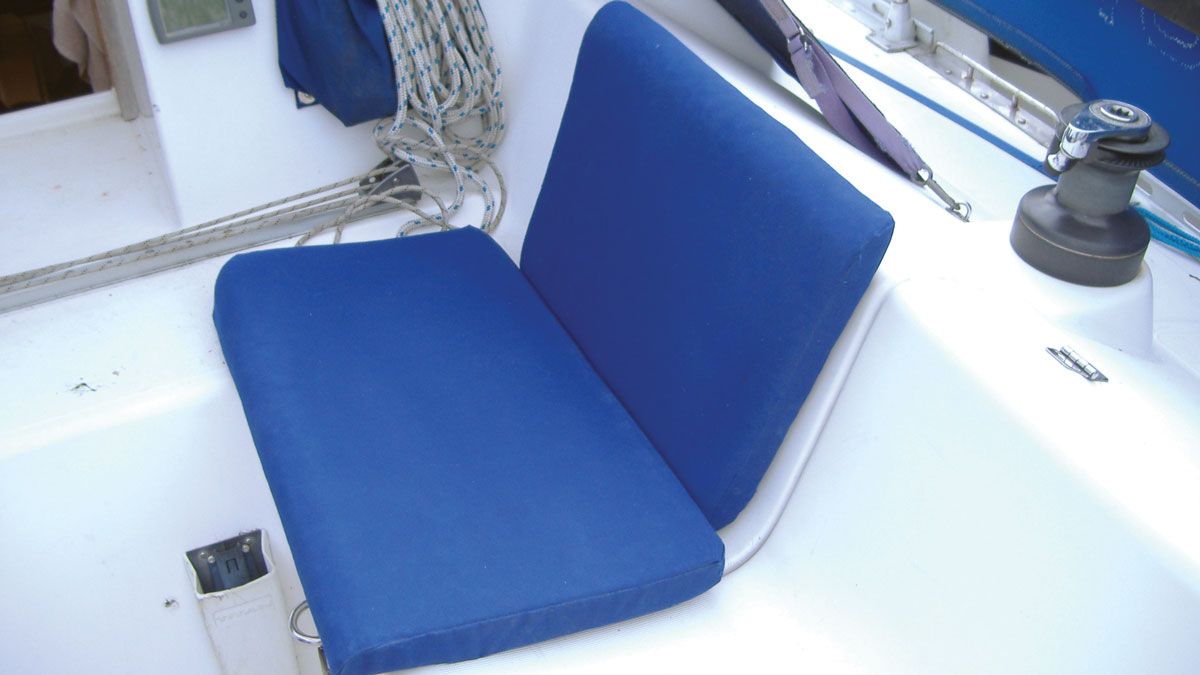Ali Wood explains the different kinds of cockpits available, and how to upgrade the space so that you can stop battling with deck gear and tripping over ropes.
Whether you’re buying a new boat or refitting an older one, the cockpit deserves consideration; probably more than you think.
While a spacious saloon or forepeak cabin is appealing, the cockpit is where you spend most of your cruising life.
Perhaps you have a big racing crew who keep tripping over each other, or family and friends who prefer to dine around a big sociable table. Or you’re double-handing, and you’ll need it to be geared up for quick and easy sail handling if conditions change.
Whatever your sailing style, there are ways to enhance your cockpit, but you may have to compromise a little too.
Different styles of cockpit
What makes a good cockpit for one crew is not the same as another.
While older boats tend to have deep, narrow cockpits, providing a cocoon where you can easily brace yourself in a gust, they can feel cramped, and only allow for a quarter berth aft.
Roomier and shallower designs, typical of modern cruisers, tend to be faster downwind, and have cockpits that allow not only for drinks, dining and barbecues, but a large aft cabin below.
The downside, of course, is the possibility of being thrown about in heavy seas, which is where safety features such as footrests and handholds come in.
Coaming tops should ideally be wide enough to sit on; narrow ones, which force you to huddle inside the cockpit, can feel claustrophobic.
Centre cockpit
For standing headroom in the aft cabin, a centre cockpit boat is an option, and provides more comfort in pitching seas, but the height above the water increases the sideways pendulum motion. Being further forward, visibility to leeward can also be obstructed by an overlapping headsail.
New centre cockpit designs are rarely encountered these days, though there were many built through the 1970s to the 90s by yards such as Moody, Contest and Westerly, some on boats as small as 33ft.
According to Phil Dollin, a director at Inspiration Marine, there’s still a demand for centre cockpit yachts.
“Occasionally on brokerage we get them and they sell quickly. It’s a shame not many are made. Perhaps one reason is that in places such as the Med, you moor stern-to, and in a centre cockpit design you can’t get off the back as easily.”
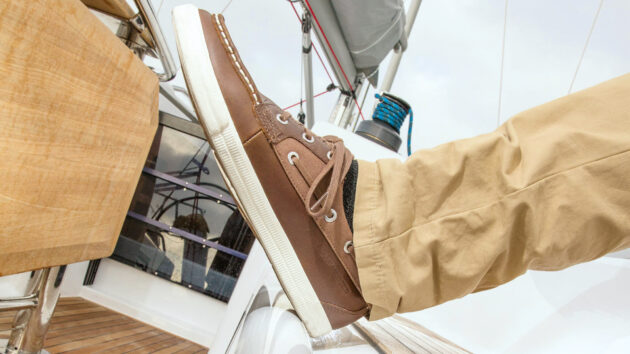
Wide cockpits, as on this Dehler 42, have footrests so you can brace yourself. Photo: Moody Yachts
Deck saloon cockpit
Another roomy option is a deck saloon, where the living area is above decks. Two helm positions – one inside, and one out – is a huge bonus in inclement weather.
“There are yachts that refer to themselves as deck saloons, but the real concept is being able to sit inside and see out,” explains Dollin. “Moody pioneered this in 1989. They did a range called the Eclipse, which was the 33, 38 and 43.”
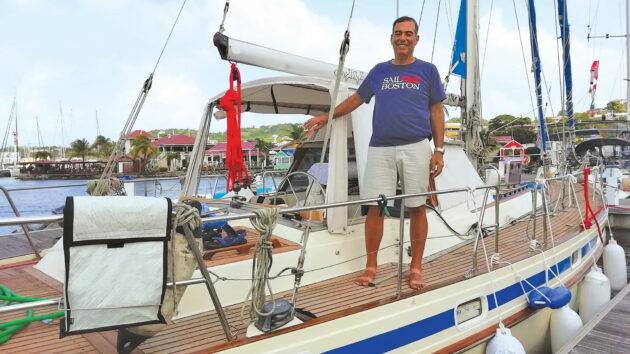
Centre cockpits such as on this Contest 43 are not so common these days. Photo: Ali Wood.
Boatbuilders such as Oyster, Southerly and Sirius have also produced deck saloons but Moody’s ‘one-level living’ is a brand new concept, where there are no steps at all between cockpit and saloon.
The Moody Decksaloon 41, 48 and 54 have sliding doors from the cockpit to the living area, giving an open-plan feel, similar to that found in multihulls.
Multihull cockpit
For ultimate cockpit space, cruisers – particularly those headed for the tropics – are increasingly opting for catamarans.
The Atlantic Rally for Cruisers (ARC), previously dominated by monohulls, now has a separate class for multihulls, which make up over a third of entries.
A big advantage with a multihull is there’s a lot less motion, and more living space, with ARC crews reporting they played Scrabble and left drinks on tables in rolling seas.
Most catamaran sailors also cite open-plan living as one of the benefits. When you can walk from the cockpit to the saloon, have the kids playing on the nets, the navigator on the same level (or in some models a bridge deck) and snorkellers on the bathing platform, you no longer have the upstairs/ downstairs feel of a monohull, where a crew can be pulled away at any minute for a sailing manoeuvre, or to check the dinner.
When Stef and Rich Stevens decided to cross the Atlantic with a baby and toddler, they swapped their Beneteau Oceanis 423 for a Nautitech 46 Open.
Skipper Rich said: “It’s all open, everyone’s in one place and the helm is on the same level… if we were on a monohull and Stef and the kids were stuck down below it would have been a lot harder.”
Meanwhile, Stef, who did the bulk of childcare, was grateful for the panoramic view of the ocean, which you don’t get on most monohulls. It also meant she could pop out and help with sail changes, while still keeping an eye on the children through the glass doors.
Having a continual fresh breeze and view of the horizon, not to mention the stability of a catamaran, is also a benefit to those who suffer seasickness.
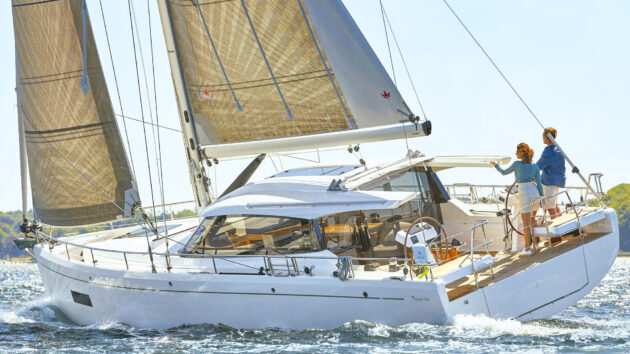
The Moody 41DS has a sliding door from the cockpit to the living area. Photo: Inspiration Marine.
Short-handed or crewed?
Cruiser-racer cockpits have not changed much over the years, but Phil Dollin has seen big developments in cruising boats.
“I’m looking out of my office window at a sporty J45, and the winch layout is exactly the same as the Dehler and the Grand Soleil… the principle of six winches spaced out hasn’t changed in 20 years,” he says. “The things that have changed are the cruiser-cruisers, such as the Hanses, all with the function of making the boat easier to sail short-handed. The winches are getting closer to the helm position.”
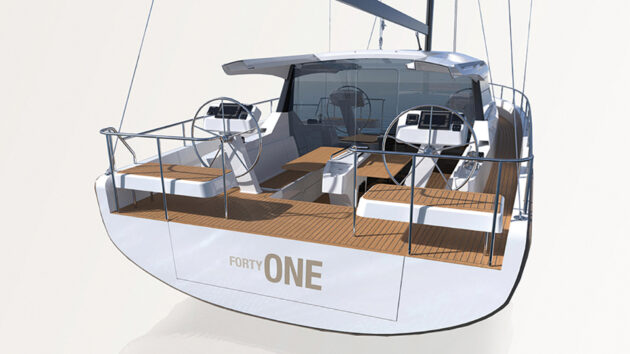
One-level living is a development of the deck saloon boat. Photo: Moody Yachts.
Dollin adds that cockpits are getting wider too: “Gone are the days of getting your foot onto the other side of the cockpit to brace yourself. Table structures have footrails to do this job instead. Plus, boats are designed to sail a lot flatter than they used to.”
So if you’re test-sailing a boat, try out the winches in the way you’d expect to use them at home, and if that’s short-handed, resist the temptation to use extra crew such as the broker or seller, no matter how well they know the boat.
When RYA Yachtmaster student Carol Wu bought her first boat, a Hallberg-Rassy 340, she was surprised by how difficult it was to do tasks single-handed, which she’d never had to do on courses.
“The most daunting thing about owning a boat is that from the very beginning, I was short-handed, either on my own or I had one other person,” she told PBO.
“It just really dawned on me that nothing I learned at school applies. How do you get all the lines to slip when you only have one pair of hands? How do you keep the boat to windward to hoist the main?”
This is where cockpit design can be friend or foe.
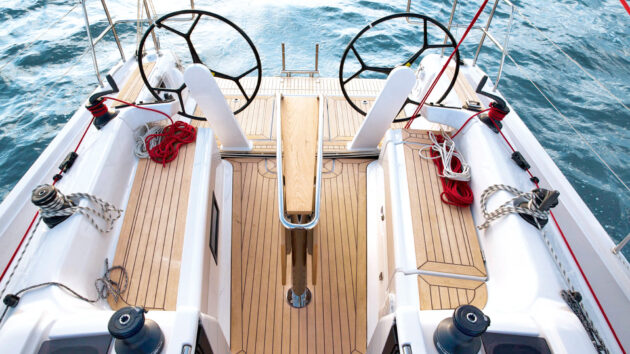
This six-winch layout is typical of a cruiser-racer. The helm will require crew to work the winches. Photo: Inspiration Marine.
Phil Dollin points out the crucial differences in cockpit design between cruising and performance boats.
A cruiser-racer such as a Dehler 38, for example, will typically have more winches than a cruiser; two for the mainsheet, two for the jib and two more on the coachroof for reefing, vang and pole-up, pole-down.
These will be spaced a good distance apart on the assumption there’ll be a crew member on each winch, and they don’t want to impede each other. You’ll also have adjustable tracks for the genoa and mainsheet, with the latter taking up cockpit space.
A cruiser on the other hand, such as Hanse 458, has only four winches, and everything needed to control the mainsail and jib leads back to the cockpit in easy reach of the helm.
The jammers are banked together and labelled, and some people opt for a colour-coded system to further distinguish lines and their different roles. The second set of winches, out of reach of the helm, will be for more occasional sails such as a cruising chute.
With modern cruising boats, you tend to get the mainsheet forward of the spray-hood, so there’s no point in having a traveller as it’s not easy to reach.
The benefit, though, is a cleaner, safer cockpit which is easier to move around in and for short-handed crew to manage.
Finally, instead of having an overlapping headsail, Dollin suggests you might opt for a self-tacking jib on a cruising boat, which can still be trimmed, but doesn’t require a separate crew member on the winch in order to tack.
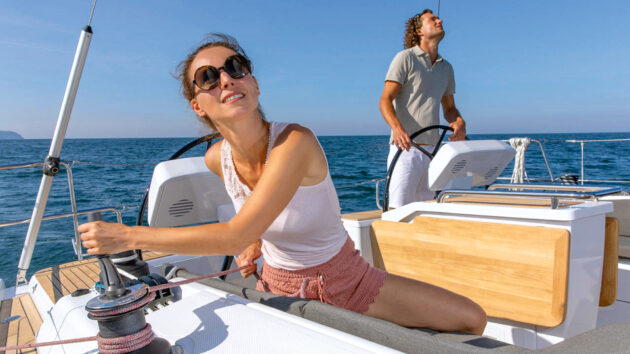
The Hanse 458 cruiser has just four winches and is suited to short-handed crew. Photo: Inspiration Marine / Hanse.
Ten quick tips to improve your cockpit
- Attach rope bags near winches to tidy loose lines.
- Ensure there are plenty of non-slip patches, especially on coaming-tops and bridge deck.
- Fit enough harness attachments for all regular working crew and helmsman
- If you can’t brace your feet against a table or the seat opposite, attach a permanent footrest between the two.
- Engine controls and instrument panels can often be moved to a better location.
- Add more handholds.
- Check cockpit drains are clear and replace rusty gate valves with proper seacocks.
- Mug holders (like the above from Force 4) reduce the danger of hot drinks flying around.
- Partition deep lockers so smaller items can be found easily.
- Ensure your gas bottle locker is properly sealed.
Electric winches
ARC sailors Claire and Malcolm Wallace crossed the Atlantic in a Discovery 58 in 2022, and were thrilled with how easy it was to sail.
“We’re seriously lazy sailors,” said Claire. “We do very little. We sit on our backsides because once the boat is set up, everything is easy. It’s built for two people to sail, and everything comes back to the cockpit apart from twin poles at the front.”
However, they had electric winches for the first time, and didn’t realise how powerful they were. They unknowingly applied excess force to a halyard wrap, causing one of the two forestays to break.
“The forestay was held up by the halyard, but when I released it the whole thing came crashing down, and the boat was rocking around like a bucking bronco,” said Malcolm. “I was looking at £10,000 worth of sail half-open under the boat.”
Incredibly, they managed to recover the sail and put in to Cape Verde for repairs at the workshop Boat CV. Now they have a rule that should they meet unexpected resistance with electric winches, they stop, monitor the issue, and if necessary transfer to manual winches.
Preventers
Poorly placed winches can force you either to dangle over the leeward coaming, or stand in the path of a wildly swinging boom. Boom height is a consideration, as is the position of the traveller, and if you’re concerned about gybing, especially on prolonged downwind passages, consider rigging a preventer.
Spar manufacturer Seldén advises setting up a preventer from the aft end of the boom to prevent the boom buckling, even if you have a mainsheet in the centre of the boom. This is because the boom is designed for downward and sideways force, not the direct sideways force you get from a preventer working hard to stop the gybe.
Gybing devices, such as the Wichard Gyb’Easy and the Walder Boom Brake are another option. These are friction devices, designed to allow the boom to move through the wind slowly, rather than hold the boom in place. They sit beneath the boom in addition to the mainsheet and a long line then braces the boom down to the side deck and runs back to the cockpit for adjustment.
Safety in the cockpit
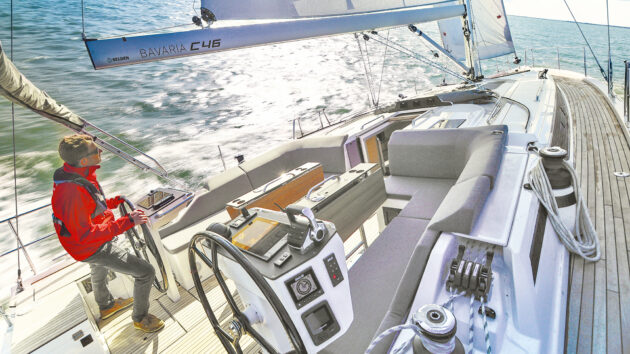
Many modern cruising boats have high booms and mainsheets on the coachroof, which is great for safety. Photo: Paul Wyeth.
The cockpit is where you’ll fit most of your safety equipment, ready to retrieve a man overboard (MOB) or deploy a drogue, and many of these items can be secured to guardrails.
In fact, ARC participants are not allowed to set sail without an extensive array of safety equipment, a list of which can be found at pbo.co.uk/safetyregs. Rally organiser World Cruising Club specifies, among other things, that participants have a lifebuoy, danbuoy or MOB recovery module incorporating these.
In addition, they should carry either a lifebuoy with a drogue, light and whistle and method of recovery, or a recovery sling and throwing/heaving line.
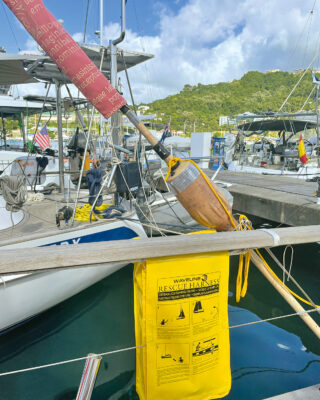
Many safety items can be mounted on guardrails. Photo: Ali Wood.
Many cruisers add cockpit netting for children and pets, but don’t let that lull you into a false sense of security; lifejackets and tethers are a must.
When seated, you want the crew to be able to brace themselves against something, whether that’s the leeward seat edge in an older design, or the table footrest in a modern, wider cockpit.
D-bolts, or dead-eyes for harness attachments are mandatory in new boat cockpits, but may be lacking on older boats. Sharing them is not a good idea as you can accidentally release the wrong harness, so make sure you have enough to begin with.
Many ARC sailors, such as the Smith family, who did the rally in 2023 on Moody 54 Blue Pearl, have a policy of staying clipped on at all times. However, so that they didn’t have to continually clip and unclip themselves from the D-bolt, skipper Neil retrofitted jackstays in the cockpit.
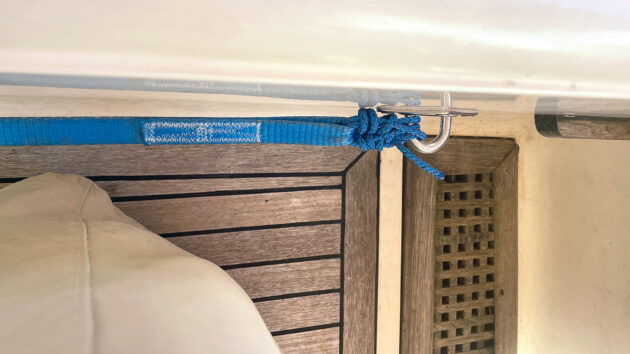
This jackstay has been retrofitted to the cockpit for long-distance cruising. Photo: Ali Wood.
When fitting jackstays, marine surveyor Ben Sutcliffe-Davies says to think carefully about where the strap ends.
“You don’t want to find yourself hanging off the back of the transom,” he warns. “Consider the length of your life lines. Some people site their jackstays on the side decks, but sometimes the coachroof is safer.”
Sutcliffe-Davies also says to check your harness clip actually fits the D-bolt: “You’d be amazed the number of times I ask people to check and they don’t actually fit!”
Drain sizes are a prominent feature of the Recreational Craft Directive (RCD) and many yachts have a walk-through transom, with a removable seat to allow the release of water.
Sutcliffe-Davies points out that older boats had crossed drains, so starboard would drain to port and vice versa. “Hardly any of that stuff happens in boat design these days. I was on a yacht the other day and we were heeling so far to starboard the water was backing through!”
Gas lockers
According to Sutcliffe-Davies, it’s frightening how many gas lockers are not sealed properly. On our last PBO Project boat, the locker was a makeshift plywood box. Sutcliffe-Davies threw a bucket of water in it and it leaked everywhere.
“Imagine if that was gas,” he warned. Gas explosions on boats are sadly still all too common. If you don’t have a sealed gas-tight locker with a drain, put it on your list now.
Solar arch
As solar technology improves, yachts are carrying increasingly more solar panels, but the question is, where to put them?
Flexible panels installed on the coachroof mean you can keep the cockpit clear, but efficacy can be impeded by shade from the sails.
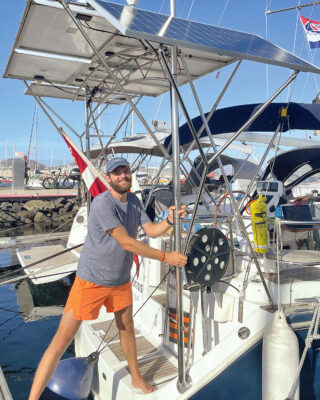
This adjustable solar arch means solar panels can be pointed to the sun. Photo: Ali Wood.
Another option is to fit a solar arch. We saw a wonderful example of this on a Beneteau Oceanis 423 in Gran Canaria. Skipper Rasmus Haurum Christensen had the arch made by a local welder, with adjustable poles so he could point the port and starboard panels directly at the sun.
The difference the angle made actually doubled the power output, as Rasmus showed us on his phone app.
Sprayhoods for your cockpit
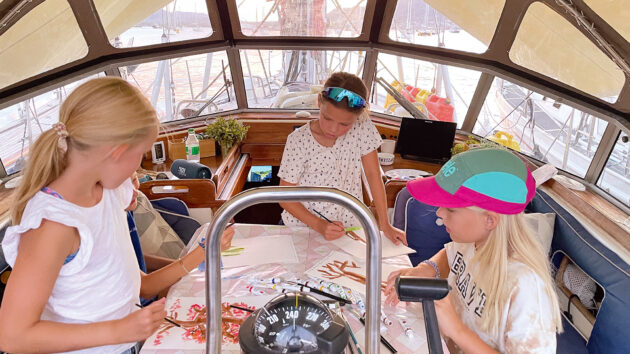
A cockpit cover is essential in hot climes. Photo: Ali Wood.
Sprayhoods are indispensable when the weather turns or the sea gets choppy.
For the greatest protection, they should have tough fabric side panels extending over the coamings.
Make sure you try them for size; some are so low they prevent access to the halyard winches, but you also need to ensure the windows are at the right height for the helm so as not to obscure visibility.
Biminis and boat tents
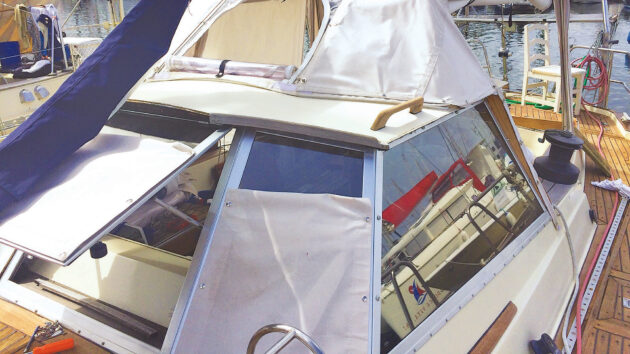
PBO reader Nitzan Sneh fitted his own bimini to his Contest 43. Photo: Ali Wood.
If you’re planning on cruising in warmer climes, a bimini is essential, and the frame needs to be strong enough that you can leave it in place while sailing.
For winter sailing, on the other hand, a boat tent can give you a whole extra room. The cockpit takes up a third of the length of your yacht, so by enclosing it with a cockpit tent you can create much more usable space.
Many Scandinavian cruisers make use of these. When the sun peeks out, it’ll act as a greenhouse, creating a cosy spot to enjoy the scenery, even if it’s literally freezing outside. These normally adjoin the sprayhood or a fixed windscreen and are supported by a folding metal frame.
Tables and chairs
Cockpit tables range from small folding designs available in chandleries to large fixed ones with fold-out leaves and handholds. Do you need a fixed table? It’s nice for the crew to eat together alfresco, without having to balance bowls on their laps. Or will you be spending more time sailing and eating in the saloon, in which case a clear cockpit could be better?
Either way, decent drink holders are a good idea. Force 4 Chandlery sells a range of options from PVC to stainless steel, which can be mounted on the rail, guardrail or bulkhead.
Cockpit cushions add to creature comforts and can be made to order or bought off the shelf. Compass24, for example, sells a seat cushion with backrest, which not only clips on to the guardrail to stop you losing it, but floats and can be used as a swimming aid.
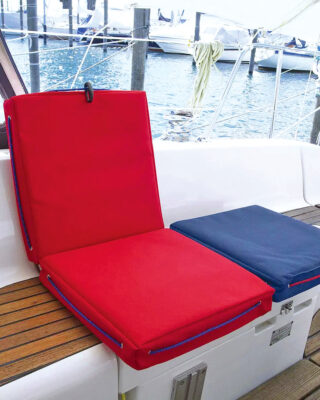
This portable seat doubles as a float. Photo: Compass 24.
Lockers and rope tidies to keep your cockpit in order
A tidy cockpit is a safe cockpit, and Jimmy Green Marine has some excellent solutions to stop crew from tripping over ropes. Produced in-house by the sewing team, halyard bags are not only great for rope tails, but for holding small items such as winch handles, phones, hand-bearing compass, binoculars and snacks.
You can attach them with a screw, bolt, lashing or cable tie, or you can add guardwire clips to hang them on the rail.
Rope tidy hooks, or ‘line tamers’, are another quick and easy solution for dealing with messy ropes.
Jimmy Green also makes a Storage and Portage Bag for items such as rope or short lengths of chain, which you can keep in a locker.
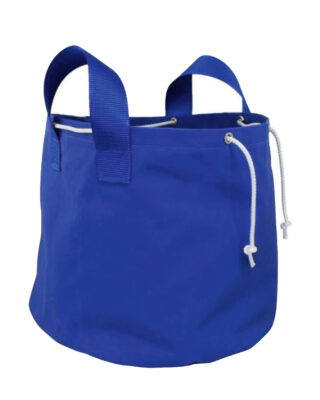
Storage and Portage bags help keep ropes and cockpits tidy. Photo: Jimmy Green Marine.
In newer designs, large cockpit lockers have given way to double aft-cabins. Most boats still have one deep locker, but you may find it more useful to add bags, shelves or partitioning so small items don’t get lost amongst big ones.
Really deep lockers will benefit from a set of fixed steps so you can climb in and out. While you’re at it, why not install a light, preferably red, so you can find things at night without a torch?
Wheel size
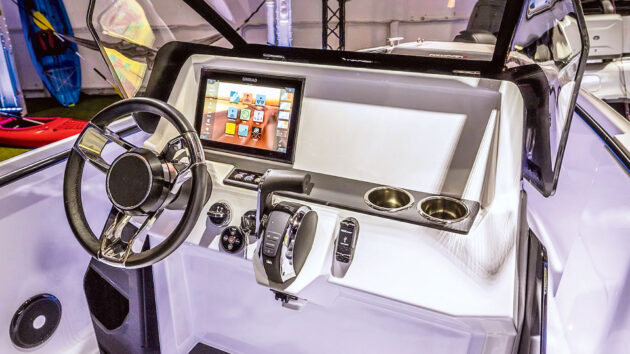
Waterproof USB plugs can be fitted outside. Photo: Scanstrut.
Most boats over 35ft will have wheel steering, which is far easier to handle than a tiller in heavy weather, but it’s worth giving some thought to the size of the wheel. It needs to be large enough so the helmsman can sit outboard to see past the coachroof, but the larger the wheel, the more it restricts cockpit access.
If you’re sailing short-handed, make sure the mainsheet and primary winches are within easy reach of the helm.
Self-steering
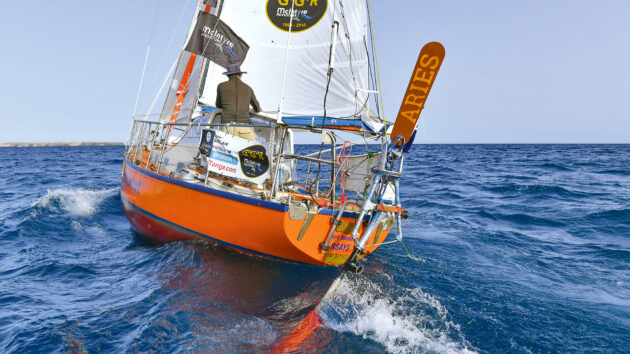
A wind vane is a great addition, but you may have additional lines to contend with. Photo: Christophe Favreau / PPL / GGR.
For long passages, wind vane self-steering is a great idea. It’s quiet and reduces the drain on batteries, not to mention the crew.
Instead of steering to a compass course, you steer the boat to the wind, thanks to a mechanical vane mounted on the transom. Once you’ve decided on your heading and adjusted the sails accordingly, the wind vane ensures you stay properly trimmed, sail efficiently and avoid the risk of a crash gybe.
The payoff is that steering lines can clutter the cockpit, but with a direct drive system, you have an additional rudder, which can also act as a backup in an emergency.
Instruments
Are your instruments in the right place?
In older boats, engine control panels are sometimes tucked away at ankle level in remote corners of the cockpit. Equally, in tiller-steered boats, throttle levers can be mounted below the waist.
Sailing instruments mounted beneath halyard winches are not ideal, because you can be sure the lines will dangle in front of them just as you need to check the heading (which is where a halyard bag comes in).
Hatch-mounted instruments are good for all-round visibility, though more difficult to install, while binnacle displays are great for the helmsman, but not the rest of the crew.
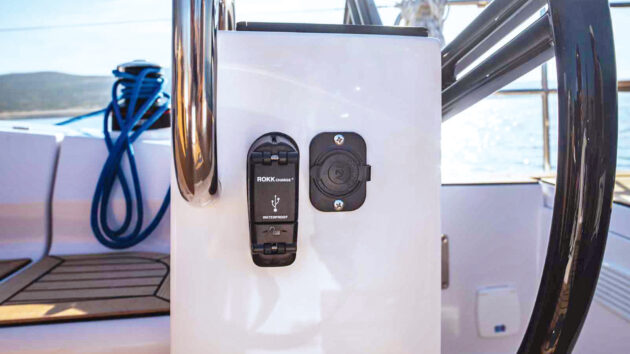
USB plugs can even be installed at the helm. Photo: Scanstrut.
Many boats these days power chart plotters, weather and routeing apps from mobile phones and laptops.
To avoid the risk of damage, or the inconvenience of having to keep popping down below, you can fit waterproof USB ports in the cockpit.
Scanstrut does a range that are either waterproof while in use or when the cover is closed. They can be installed in many different locations on the boat.
Don’t forget to be nosey!
There’s no end to what you can add to a cockpit to enhance it. Many bluewater cruisers now have Starlink satellite communication, along with radar and solar arches, a bathing platform, ladder and davits.
Some have stereo speakers and barbecues; others have sophisticated fishing gear and side decks crammed with bikes, surfboards and paddleboards. Next time you’re visiting the marina, or perhaps on holiday in the Med, why not take some pictures of liveaboard boats and learn from those who’ve tried and tested ideas?
Or for a virtual tour, take a look at dealership videos of used boats, such as those by Boatshed, where you can compare cockpits and see what other boat owners do.
Have some cockpit tips to share with PBO readers? If so, we’d love to hear from you at pbo@futurenet.com.
Best centre cockpit sailboat designs: the Moody 34 and 346 + 5 alternative yachts
The Moody 34 and 346 were the smallest and best-selling of Moody’s centre cockpit sailboat models in the 1980s. Rupert…
How to make cockpit cushions
Paul Vellacott discovers that making cockpit cushions saves money and is comfortably within everyone’s capabilities
Want to read more articles about cockpits and different boat styles?

A subscription to Practical Boat Owner magazine costs around 40% less than the cover price.
Print and digital editions are available through Magazines Direct – where you can also find the latest deals.
PBO is packed with information to help you get the most from boat ownership – whether sail or power.
-
-
-
- Take your DIY skills to the next level with trusted advice on boat maintenance and repairs
- Impartial, in-depth gear reviews
- Practical cruising tips for making the most of your time afloat
-
-
Follow us on Facebook, Instagram, TikTok and Twitter

